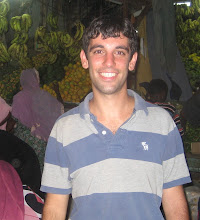Tuesday August 29: The Other Side of the Wall
My first Chronicle column submitted from abroad proved to not be as logistically easy as I had hoped. The version that ran was sadly not the final version of what I wrote. However, you, faithful blog reader, can enjoy that version here!
************************************************
“Everyone should attend a Communist rally once in their life,” my friend gushed. “There’s something so genuine about it.” The Communist Youth Union Green Summer Campaign welcome rally had just concluded in Ho Chi Minh City, Vietnam and it was time to work.
This summer six American students from Duke and the University of North Carolina and six Vietnamese students joined to spend two months living together and working in some of Vietnam’s poorest hamlets. The partnership was a huge deal in Vietnam—our trip was front page news in the biggest national newspaper.
Before we came to Vietnam, our group wondered what it would be like working in an area our country had destroyed with people who a little more than thirty years ago were our mortal enemies. What we found was a momentous lesson in the power of forgiveness and the ability to start anew.
The province where we worked, Ben Tre, was a sight of fierce fighting during the Vietnam War (or the American War). A US general here famously remarked that “We must destroy the village in order to save the village.” The area was completely ruined.
There are many reminders of the war in Vietnam. At the War Remnants Museum in Ho Chi Minh City, the chilling Agent Orange dioxin display features pictures of horribly maimed adults, crippled children, and even two jars containing hideously deformed pickled human fetuses.
The Cu Chi tunnels are the site of hundreds of miles of tunnels north of Saigon that were the Viet Cong’s underground base. Our tour began with the most blatant propaganda film possible about the “evil Americans” who bombed and destroyed young, innocent children. The propaganda was painful, but it was particularly uncomfortable because we were watching with our Vietnamese roommates. What did they think about the “evil Americans?” How could they not blame us for what our country had done here?
I decided to ask my roommate directly—did most Vietnamese people today still blame the Americans? Was there any anger or resentment, even deep down?
The response I got was immediate, direct, genuine, and surprisingly poignant in its simplicity. Quy said that “That is the past, ancient times, not now.”
“But don’t you blame Americans some for destroying the country?”
He said that people didn’t think about it that way. Now the countries were working together, and that was what mattered. We were America’s youth—not the US government of the 1960s and 70s. That sentiment has been echoed so far by everyone we have met, no matter what side they were on during the war.
Complete forgiveness is not something we’re good at in America. It was only eleven years ago that we finally reestablished diplomatic relations with Vietnam. Vietnamese Americans still fight stigmas from the war every day and many Americans regard the country as a backwards Communist wasteland.
Now, thirty-three years after the Americans left Vietnam, we are back. I cannot imagine a warmer welcome. It is a terrible shame that it took so long for these relationships to be possible.
I have seen the goods and bads of Communism and one party rule. We have had the chance to exchange ideas with Vietnamese youth in enlightening discussions of politics, economics and even popular culture. In fact, there are areas like getting government information to rural citizens, gun control and fighting violent crime where the Vietnamese are far more effective than Americans. There is a lot we can learn from the Vietnamese Communists.
I worry though, that at the same time that we are slowly reconciling painful divisions from the past, our government is busy creating new fissures that will take another thirty years to heal. Every time our government rushes to condemn other nations, sever relationships, or worst, bomb whole cultures to destruction, we are putting up walls that do not come down easily.
Perhaps it is easy to dismiss those on the other side of the world as mere abstractions or figures in a body count. During the war, American soldiers were told they were killing communists—not people.
In Vietnam there is a war memorial very similar to our Vietnam Wall. I’ve visited the Vietnam War Memorial in Washington D.C. many times, but I had never really wondered about “the other side of the wall.” Each name on the wall in Vietnam is just as tragic a loss as our own wall.
So before we rush off to pursue American agendas in today’s wars—or tacitly support or even not adamantly oppose the violent fissures we are creating—think about standing on the other side of the wall.


0 Comments:
Post a Comment
<< Home